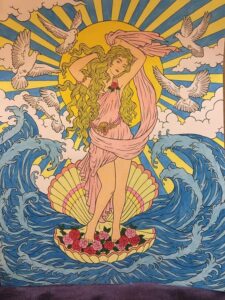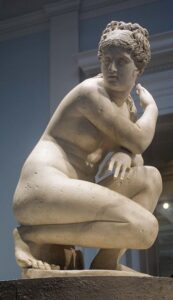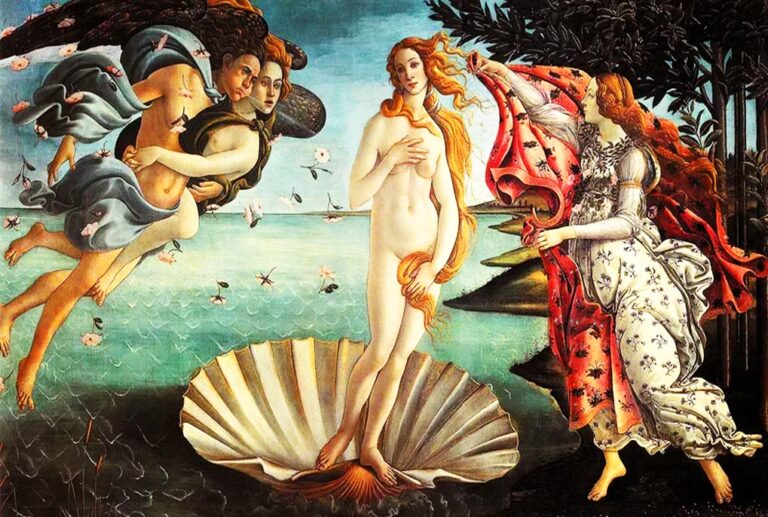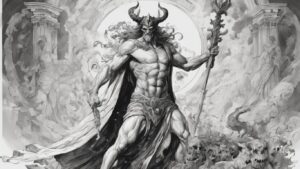Table of Contents
Aphrodite, a prominent figure in Greek mythology, is the goddess of love, beauty, and fertility. According to the myths, she emerges from the sea foam near the island of Cyprus, captivating all with her unparalleled beauty. Recognized as one of the twelve Olympian deities, Aphrodite holds the power to inspire love and desire among both gods and mortals. She is often associated with the sea, and her birth and exploits are subjects of various ancient Greek stories and legends. In Roman mythology, Aphrodite is equated with the goddess Venus. The worship of Aphrodite was widespread in ancient Greece, and her influence extends to art, literature, and popular culture.
Origins

A fascinating aspect of Aphrodite’s Greek mythology involves her origin. In Hesiod’s “Theogony,” Cronus castrated Uranus, and from the sea foam, Aphrodite emerged fully grown and beautiful. Carried to the shore on a shell, the Horae, goddesses of the seasons, received her.
This birth narrative emphasizes Aphrodite’s connection to the sea and her association with beauty and fertility. It’s worth noting that there are variations of this myth in different ancient sources, and some poets and writers presented alternative versions of Aphrodite’s birth.
This story of her origin underscores her unique and enchanting nature, linking her to the fundamental elements of the ancient Greek cosmos.
Legends and Stories
The Birth of Aphrodite: Aphrodite, the goddess of love and beauty, emerged from the sea foam near the island of Cyprus. In this captivating tale, the sea foam resulted from the mingling of Uranus’s blood and the ocean after Cronus, the Titan, castrated his father. Fully grown and radiantly beautiful, Aphrodite rose from the waves and was carried to the shore on a shell. This mesmerizing birth narrative solidifies her connection to the sea and underscores her irresistible allure.
The Trojan War: A central figure in the Trojan War, Aphrodite shaped events, promising Paris the love of Helen. Her influence unfolded in the epic conflict on the plains of Troy, leaving an indelible mark on the narrative.
The Sculptor: In another intriguing tale, Aphrodite became the inspiration for the renowned sculptor Pygmalion. Unimpressed with mortal women, Pygmalion crafted a statue of the ideal woman, pouring all his artistic skill and love into his creation. Aphrodite, moved by his devotion, brought the statue to life, and Pygmalion’s ivory maiden transformed into a living, breathing woman. This story showcases Aphrodite’s power over matters of the heart and her ability to kindle love in unexpected ways, blurring the lines between art and reality.
Family

In Greek mythology, Aphrodite is a prominent member of the Olympian pantheon and has familial ties with other major gods and goddesses. Here is an overview of Aphrodite’s family:
Parents:
Uranus and the Sea (Foam): In the most well-known version of her origin, Aphrodite’s birth is unconventional. She is said to have emerged from the sea foam that resulted from the castration of Uranus, the sky god, by his son Cronus. This unique birth is a central part of her mythology, emphasizing her connection to the sea.
Family:
Hephaestus, the god of blacksmiths, is Aphrodite’s husband. Their marriage, often depicted as tumultuous, saw Aphrodite having affairs, notably with Ares, the god of war.
Aphrodite is associated with various offspring. In many myths, she is considered the mother of Eros, the god of love and desire.
Harmonia: In some accounts, Aphrodite and Ares are the parents of Harmonia, a goddess associated with harmony and concord.
Engaging in numerous love affairs, Aphrodite, besides her marriage to Hephaestus, is associated with diverse offspring and lovers, including:
Ares: God of war, with whom Aphrodite had children like Harmonia.
Anchises: A mortal with whom Aphrodite had a son named Aeneas, a hero in Trojan mythology and a key figure in Roman mythology.
Aphrodite’s complex relationships and family connections contribute to the intricate web of Greek mythology, showcasing the intertwining of divine and mortal realms.
Appearance
Aphrodite, the Greek goddess of love and beauty, epitomizes beauty and grace with universally recognized features. Her appearance, subject to artistic interpretation, consistently includes:
Radiant Beauty: Universally depicted as extraordinarily beautiful, Aphrodite captivates gods and mortals with perfect features and an ethereal glow.
Youthful Vigor: Emphasizing timeless beauty, Aphrodite is perpetually young, symbolizing the everlasting and irresistible nature of love.
Golden Hair: Often described with cascading golden waves, Aphrodite’s hair symbolizes divine beauty and a celestial connection.
Elegant Attire: Adorned in flowing garments with symbols of love and fertility, Aphrodite’s attire emphasizes her association with these aspects.
Symbolic Elements: Artists incorporate symbols like roses, myrtles, and seashells to reinforce Aphrodite’s connection to love, beauty, and the sea.
Graceful Posture: The embodiment of beauty and love, Aphrodite radiates confidence through graceful and alluring poses, showcasing her divine presence.
Symbology

As the Greek goddess of love, beauty, and fertility, Aphrodite embodies various symbols representing her attributes and domains. Some key symbols associated with Aphrodite include:
The rose, a quintessential symbol, embodies love and beauty, highlighting Aphrodite’s role as the inspiration behind love and desire.
The myrtle plant, sacred to the goddess, intertwines with love and marriage, as ancient Greece utilized myrtle wreaths in wedding ceremonies to symbolize love and fertility.
Symbolizing her birth from the sea, the seashell represents Aphrodite’s maritime connection, often depicted in scenes of her rising from the ocean on a scallop shell.
The mirror, associated with self-reflection and vanity, underscores Aphrodite’s beauty and the pursuit of physical perfection.
Doves symbolize love, peace, and innocence, reflecting her graceful and gentle nature.
The playful cupids or erotes, depicted as Aphrodite’s companions, embody the mischievous aspects of love.
A magical girdle, or cestus, enhances Aphrodite’s allure, possessing the power to inspire love and desire.
In the Judgment of Paris, an apple symbolizes Aphrodite’s victory, chosen as the fairest goddess in this mythical contest.
Aphrodite FAQ
Who is Aphrodite?
Aphrodite is a goddess in Greek mythology, associated with love, beauty, and fertility.
What is Aphrodite the god of?
Aphrodite is the goddess of love, beauty, and fertility.
How was Aphrodite born?
Aphrodite was born from the sea foam near the island of Cyprus, according to mythology.
What is Aphrodite the goddess of?
Aphrodite is the goddess of love, beauty, and fertility.
How to worship Aphrodite?
Worship of Aphrodite involved rituals, offerings, and prayers, often conducted in temples dedicated to her.
Who is Aphrodite married to?
Aphrodite is married to Hephaestus, the god of blacksmiths.
What is Aphrodite's symbol?
Aphrodite's symbols include the girdle (cestus) and the mirror.
Who was Aphrodite married to?
Aphrodite is married to Hephaestus.
What does Aphrodite look like?
Aphrodite is described as extraordinarily beautiful, with golden hair and an ethereal glow.
Who is Aphrodite's parents?
In one myth, Aphrodite is born from the sea foam after Uranus's castration by Cronus.
What does Aphrodite mean?
The name "Aphrodite" means "foam-born" or "risen from the foam" in Greek.
How to pray to Aphrodite?
Prayers to Aphrodite often involved requests for love, beauty, and guidance in matters of the heart.
How to pronounce Aphrodite?
Aphrodite (/ˌæfrəˈdaɪtiː/ AF-rə-DY-tee).
Who was Aphrodite's husband?
Aphrodite's husband is Hephaestus.
What is Aphrodite known for?
Aphrodite is known for her unparalleled beauty, role in love stories, and connection to the sea.
Which Greek god is married to Aphrodite?
Aphrodite is married to Hephaestus.
What did Aphrodite do?
Aphrodite played a significant role in various myths, including the Judgment of Paris and the Trojan War.
Why did Aphrodite marry Hephaestus?
Aphrodite was forced to marry Hephaestus by Zeus as a resolution to a conflict among the gods.
Who did Aphrodite love?
Aphrodite had affairs with gods like Ares and mortal figures like Anchises.
Where does Aphrodite live?
Aphrodite's abode is often associated with the island of Cyprus.
What is Aphrodite's Roman name?
Aphrodite's Roman equivalent is Venus.
How old is Aphrodite?
In mythology, gods and goddesses are considered immortal, so age does not apply to them.
Who is Aphrodite related to?
Aphrodite is related to gods like Zeus, Hera, Apollo, and Athena.
Where can Aphrodite be found?
Aphrodite can be found in various myths, literature, and artworks inspired by Greek mythology.
Why is Aphrodite important?
Aphrodite is important for her influence on love, beauty, and the human experience of passion and desire.
How many children did Aphrodite have?
Aphrodite is associated with several offspring, including Eros and Aeneas.
What powers does Aphrodite have?
Aphrodite has the power to inspire love, desire, and beauty.
How did Aphrodite die?
In classical mythology, gods and goddesses are typically immortal, and there is no account of Aphrodite's death.
How many kids did Aphrodite have?
Aphrodite is associated with several children, and the number can vary in different myths.
When was Aphrodite born?
Aphrodite's birth is a mythological event, and specific dates are not assigned.
Where was Aphrodite born?
Aphrodite was born from the sea foam near the island of Cyprus.
Where did Aphrodite come from?
In mythology, Aphrodite emerged from the sea foam near Cyprus.
What does Aphrodite like?
Aphrodite is associated with love, beauty, and the pleasures of the senses.
Who is the father of Aphrodite?
In some myths, Uranus is considered the father of Aphrodite, indirectly through the sea foam.
What does Aphrodite represent?
Aphrodite represents the divine embodiment of love, beauty, and fertility in Greek mythology.




